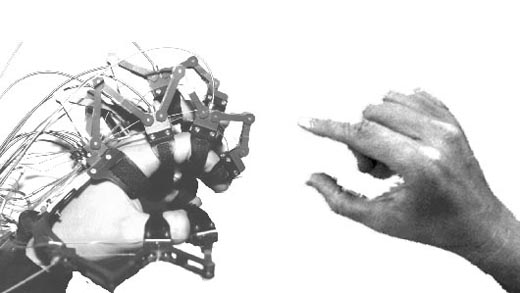| The years 1993-1995. The ubiquitous computing concept had taken hold, and many of us started to think more freely beyond the traditional computer with its keyboard and mouse. Pen input was clearly a simpler way to interact in many situations, but the idea of being able to gesture to the computer seemed even more promising. Two studies were undertaken under a grant from the Danish Research Councils (principal investigator: Elin Rønby Pedersen): Scribbling and HandWaving. |
||
| Scribbling was a continuation of the Tivoli project, aiming at a note sized "document" form factor as a component in a Tivoli object world. |  |
|

|
||
| Hand Waving explored the technical feasibility of controlling computers by hand gestures without having to succumb to wearing gloves or similar entanglements (M.Sc. thesis by Tomas Sokoler). | ||
| Integration of live video into our computers also started happening in the early 90s, and it represented a further broadening of the interaction scope, not only could we display streaming video, but video capture would from now on be considered a basic input type. Work based mediaspaces had been in wide use within Xerox PARC and many other research labs. Early usage indicated that media spaces were used more often as a means to be aware of each other than as a direct communication device (people would often use the phone if they wanted to talk!) Casablanca
aimed at addressing multiple known issues with media spaces: tendency
of intrusion and lack of privacy, as well as displeasing images and
sound from over-stressed communication lines. The approach was called,
"Less is more", and it was basically a specialized media space
that supported awareness; the challenge was to understand what kind
of situations would call for what kind of awareness. The project was
started in 1995 at Interval Research Corporation. The project included
an extensive ethnograpic mapping of a dozen of households with emphasis
on how the members communicated with each other and with people outside.The
project continued for a couple of years, as described in the summary
paper by D. Hindus et al: Casablanca: designing social communication
devices for the home. ISBN:1-58113-327-8, pp. 325-332; it was presented
at CHI 2001 in Seattle. |
||